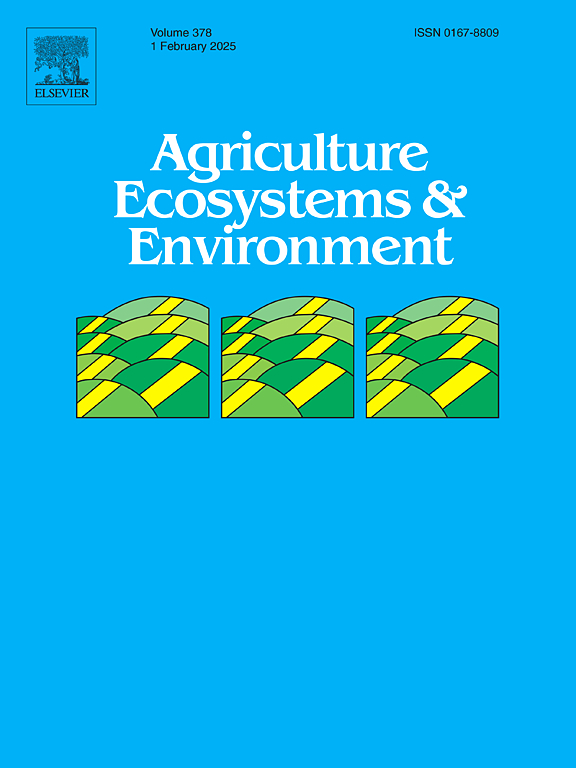基于知识的磷投入水平控制着稻田土壤微生物多样性与生态系统功能之间的联系
IF 6
1区 农林科学
Q1 AGRICULTURE, MULTIDISCIPLINARY
引用次数: 0
摘要
以知识为基础的农田磷(P)投入是一种获得认可的管理方法,可提高土壤磷供应和作物产量。为保持作物产量并确保磷资源的有效利用,更好地了解磷肥投入对农业生态系统生产和功能服务的影响及其与土壤生物多样性的关系至关重要。为探索钾肥投入水平对水稻田多重生态系统功能(生态系统多功能性,EMF)的影响,特别关注土壤生物多样性与 EMF 之间的联系,建立了一项长达十年的田间试验。通过整合 22 种单一生态系统功能,我们的研究结果表明,钾肥的投入显著提高了生态系统多功能性和大多数单一生态系统功能,这与某些特征有关,包括作物生产力、土壤碳和养分储存、元素循环和微生物生长。不同钾肥投入量的土壤表现出不同的真菌、细菌和原生生物丰富度,这些对钾肥投入量的不同反应在水稻的三个生长阶段有显著差异。土壤细菌和真菌的丰富度与早稻和晚稻的 EMF 指数和大多数单一生态系统功能呈正线性关系。在微生物类群中,真菌丰富度是影响和预测 EMF 的主要因素,其次是细菌丰富度。此外,在土壤养分特性中,可利用磷含量是驱动和预测EMF的主要因素,其次是NO3-N含量。磷肥施用量对土壤微生物多样性与EMF之间的关系有显著影响,而土壤可利用P和NO3--N含量进一步调节了磷肥施用量对这一关系的影响。通过将EMF与物种丰富的土壤微生物多样性联系起来,我们的研究结果将为保持作物产量和磷的高效利用提供深入的见解,强调了了解肥料投入对农业生态系统生产和生态服务权衡的共同调控的重要性。本文章由计算机程序翻译,如有差异,请以英文原文为准。
Knowledge-based phosphorus input levels control the link between soil microbial diversity and ecosystem functions in paddy fields
The knowledge-based phosphorus (P) input in farmlands is an approved management practice for enhancing soil P supply and crop production. To maintain crop production and ensure the efficient application of P resources, it is crucial to better understand the impacts of P inputs on agroecosystem production and functional services, as well as their relationships with soil biodiversity. A decade-long field experiment was established to explore the impacts of P fertilizer input levels on the multiple ecosystem functions (ecosystem multifunctionality, EMF) of paddy fields, with particular attention to link between soil biodiversity and the EMF. By integrating 22 single-ecosystem functions, our results suggested that P fertilizer inputs significantly increased the EMF and most single-ecosystem functions, which was related to certain characteristics, including crop productivity, soil carbon and nutrient storage, element cycles, and microbial growth. The soils with different P input levels exhibited different richness of fungi, bacteria and protists, with these diverse responses to the P fertilizer inputs being significantly different across rice three growth stages. Soil bacterial and fungal richness exhibited positive linear relationships with the EMF index and most the single-ecosystem functions during both early and late rice seasons. Among the microbial taxa, fungal richness was the key driver and predictor of the EMF, followed by bacterial richness. In addition, among soil nutrient properties, available P content was the dominant driver and predictor of the EMF, followed by NO3--N content. Phosphorus fertilizer input rate significantly influenced the link between soil microbial diversity and the EMF, with the P-input-driven impacts on this relationship being further regulated by soil available P and NO3--N contents. By linking the EMF with the species-rich soil microbial diversity, our results would provide in-depth insights into maintaining crop production and P efficient utilization, emphasizing the importance of understanding the co-regulation of fertilizer inputs on agroecosystem production and ecological service trade-off.
求助全文
通过发布文献求助,成功后即可免费获取论文全文。
去求助
来源期刊

Agriculture, Ecosystems & Environment
环境科学-环境科学
CiteScore
11.70
自引率
9.10%
发文量
392
审稿时长
26 days
期刊介绍:
Agriculture, Ecosystems and Environment publishes scientific articles dealing with the interface between agroecosystems and the natural environment, specifically how agriculture influences the environment and how changes in that environment impact agroecosystems. Preference is given to papers from experimental and observational research at the field, system or landscape level, from studies that enhance our understanding of processes using data-based biophysical modelling, and papers that bridge scientific disciplines and integrate knowledge. All papers should be placed in an international or wide comparative context.
 求助内容:
求助内容: 应助结果提醒方式:
应助结果提醒方式:


